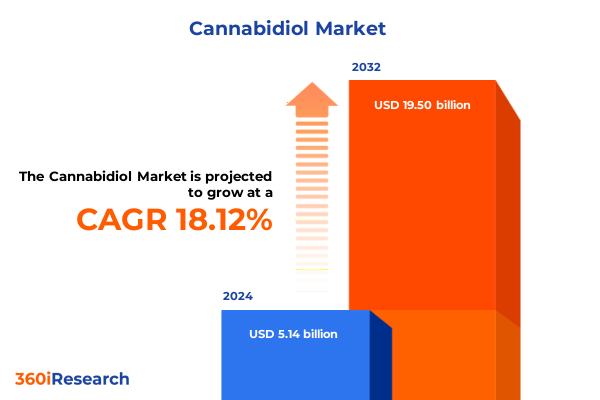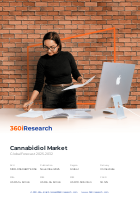The Cannabidiol Market size was estimated at USD 5.14 billion in 2024 and expected to reach USD 6.04 billion in 2025, at a CAGR of 18.12% to reach USD 19.50 billion by 2032.

Emergence of Cannabidiol as a Mainstream Wellness Ingredient Transforming Health, Lifestyle, and Regulatory Landscapes in the United States and Beyond
The evolution of cannabidiol from a niche botanical extract to a mainstream wellness staple represents a profound transformation in both consumer behavior and regulatory frameworks. Since the 2018 U.S. Farm Bill federally legalized hemp-derived CBD, market participants have navigated a complex mosaic of state-level regulations, with medical or recreational cannabis now legal in over two dozen states and territories, while 37 states permit medical cannabis use. This federal milestone has not only legitimized hemp cultivation and processing but also catalyzed innovation across product categories.
Pivotal Shifts in Regulation, Technology, and Consumer Preferences Driving Cannabidiol Market Evolution Across Global Industries
The landscape for cannabidiol has been reshaped by an interplay of regulatory revisions, technological breakthroughs, and shifting consumer values. In 2024, the DEA’s announcement to reschedule cannabis from Schedule I to Schedule III signaled a landmark change that may streamline research pathways and banking access for cannabinoid businesses. Concurrently, adult-use legalization of recreational cannabis now spans 24 states and multiple territories, further eroding stigma and broadening distribution channels.
Innovation has also turned a corner, as industry leaders deploy advanced extraction techniques like nanoemulsion for enhanced bioavailability, embrace botanical synergies to craft entourage-effect formulations, and refine personalized dosing through digital platforms. The proliferation of niche formats-ranging from pet-specific treats to anti-aging serums-reflects a consumer appetite for targeted wellness solutions. Online commerce continues to outpace traditional retail, leveraging direct-to-consumer models and subscription services to foster deeper brand relationships and capture data-driven insights.
Technological integration extends to supply chains, where blockchain-based traceability and AI-driven quality control systems enhance product integrity and regulatory compliance. As these transformative shifts converge, the cannabidiol market is poised to evolve toward higher standards of efficacy, transparency, and consumer engagement.
Assessing the Economic and Operational Fallout from United States Tariff Increases on Cannabis Accessory Imports and Supply Chain Viability
The imposition of tariffs in early 2025 has sent ripples throughout the cannabidiol sector by inflating costs for essential components like vape hardware, packaging, and cultivation equipment. A 35% duty on Chinese-made vaporizer cartridges, batteries, and related accessories has driven many companies to absorb these additional expenses initially, but persistent levies have forced a strategic pivot toward domestic or nearshore manufacturing, raising unit costs and creating quality consistency concerns. Meanwhile, base tariffs of 10% on most imports and up to 245% specifically on Chinese goods have dramatically increased the landed cost of jars, tins, and other packaging supplies, challenging businesses to protect margins without compromising price competitiveness.
Supply chain volatility has compounded these cost pressures. U.S. Customs processing times for vape cartridges, extraction machinery, and packaging materials have lengthened by nearly 18%, prompting distributors to maintain up to six weeks of buffer stock, thus tying up working capital and limiting financial flexibility. Companies are now caught between expensive domestic alternatives, which often lack the economies of scale of established Chinese manufacturers, and unpredictable international tariffs that erode the benefits of nearshoring efforts.
Comprehensive Multidimensional Segmentation Reveals Diverse Product, Channel, and Consumer Dynamics Shaping the Cannabidiol Market
A granular segmentation approach reveals how diverse product types, applications, and consumer profiles drive the cannabidiol market’s intricate dynamics. In the product domain, infused beverages have branched into juices, tea and coffee, and water, while capsules and tablets span gel capsules, softgels, and traditional tablets; edibles continue to expand through baked goods, chocolates, and gummies. Oil and tincture formats differentiate between broad spectrum, full spectrum, and isolate offerings; topicals include balms and salves, creams and lotions, and patches; vape products encompass cartridges, vape oil, and pens.
This comprehensive research report categorizes the Cannabidiol market into clearly defined segments, providing a detailed analysis of emerging trends and precise revenue forecasts to support strategic decision-making.
- Product Type
- Application
- Distribution Channel
- Source
- End User
- Strength
Regional Divergence and Convergence Defined by Distinct Regulatory, Consumer and Supply Chain Characteristics Across Major Global Markets
Regional developments articulate how local regulations and consumer preferences steer market trajectories. In the Americas, U.S. hemp-derived CBD benefits from the residual momentum of the 2018 Farm Bill and a patchwork of state frameworks, while Canada’s mature adult-use market fosters cross-border partnerships and supply chain synergies. The Europe, Middle East and Africa region is marked by landmark reforms in Germany, which in early 2024 authorized controlled adult cannabis possession and prescribing pathways, catalyzing interest in CBD-infused nutraceuticals and skincare formulations; the U.K. and France now explore nuanced regulatory models that balance public health and market access.
This comprehensive research report examines key regions that drive the evolution of the Cannabidiol market, offering deep insights into regional trends, growth factors, and industry developments that are influencing market performance.
- Americas
- Europe, Middle East & Africa
- Asia-Pacific
Leading Cannabidiol Industry Players Forge Strategic Paths Through Innovation, Partnerships, and Vertical Integration to Secure Market Leadership
Key industry participants have charted distinct strategic paths to consolidate their market positions. Charlotte’s Web continues to leverage vertically integrated cultivation and processing facilities to ensure consistent quality and supply. Medterra CBD and CV Sciences have focused on expanding their branded consumer portfolios while forging pharmaceutical partnerships to explore novel therapeutic applications. Aurora Cannabis and Green Roads emphasize global distribution networks and clinical research investments to validate efficacy claims, while CBDistillery and JustCBD differentiate through competitive pricing and digital marketing acumen. Kiva Confections and Reliva CBD Wellness tap into consumer loyalty by pioneering innovative product formats, from microdosed gummies to time-release patches, and by co-creating targeted offerings in collaboration with retailers and healthcare providers.
This comprehensive research report delivers an in-depth overview of the principal market players in the Cannabidiol market, evaluating their market share, strategic initiatives, and competitive positioning to illuminate the factors shaping the competitive landscape.
- Charlotte's Web, Inc.
- Canopy Growth Corporation
- Aurora Cannabis Inc.
- CV Sciences, Inc.
- Cronos Group Inc.
- Tilray Brands, Inc.
- Medical Marijuana, Inc.
- Green Roads Worldwide
- Medterra
- CBDistillery
- Joy Organics
- Lazarus Naturals
- PlusCBD
- Abacus Health Products
- Elixinol Wellness Limited
- Isodiol International Inc.
- HempFusion Wellness Inc.
Strategic Imperatives for Cannabidiol Industry Stakeholders to Navigate Complex Regulations and Capitalize on Emerging Growth Opportunities
To navigate this complex terrain, stakeholders must adopt a multi-pronged strategy. First, proactive regulatory engagement-participating in public consultations and alliance networks-is essential to shape pragmatic frameworks and anticipate compliance demands. Second, supply chain resilience calls for diversified sourcing strategies, balancing domestic manufacturing with flexible nearshore partnerships to mitigate tariff volatility. Third, investing in robust data analytics and advanced quality control technologies will underpin product differentiation and elevate consumer trust. Fourth, exploring adjacent channels-such as telehealth platforms for personalized cannabinoid therapies-can open untapped revenue streams. Finally, embedding sustainability practices across cultivation, packaging, and distribution not only resonates with eco-conscious consumers but also preemptively addresses forthcoming regulatory and ESG mandates.
Rigorous Primary and Secondary Research Methodology Ensuring Robust Data Integrity, Market Triangulation, and Actionable Insights for Decision Makers
Our research integrates both primary and secondary methodologies to ensure analytical rigor and actionable validity. Primary research encompassed structured interviews with growers, manufacturers, compliance officers, and health professionals to capture firsthand perspectives on regulatory shifts, supply chain constraints, and consumer preferences. Secondary research entailed a thorough review of legislative documents, trade journals, industry whitepapers, and reputable news outlets to contextualize evolving policies and market developments.
This section provides a structured overview of the report, outlining key chapters and topics covered for easy reference in our Cannabidiol market comprehensive research report.
- Preface
- Research Methodology
- Executive Summary
- Market Overview
- Market Insights
- Cumulative Impact of United States Tariffs 2025
- Cumulative Impact of Artificial Intelligence 2025
- Cannabidiol Market, by Product Type
- Cannabidiol Market, by Application
- Cannabidiol Market, by Distribution Channel
- Cannabidiol Market, by Source
- Cannabidiol Market, by End User
- Cannabidiol Market, by Strength
- Cannabidiol Market, by Region
- Cannabidiol Market, by Group
- Cannabidiol Market, by Country
- Competitive Landscape
- List of Figures [Total: 32]
- List of Tables [Total: 1431 ]
Synthesizing Cannabidiol Market Trends and Strategic Imperatives to Chart a Cohesive Pathway for Stakeholder Success in a Dynamic Landscape
In synthesizing these insights, it becomes clear that the cannabidiol sector stands at an inflection point defined by regulatory recalibration, technological advancement, and evolving consumer expectations. While tariff-induced cost pressures and regulatory divergences present real challenges, they also galvanize innovation and strategic realignment. As stakeholders refine their market approaches-optimizing segmentation, fostering cross-border partnerships, and prioritizing data-driven quality assurances-they can harness the full potential of cannabidiol’s expanding role across wellness, healthcare, and lifestyle arenas.
Engage with Associate Director Ketan Rohom to Unlock In-Depth Cannabidiol Market Insights and Secure Your Comprehensive Research Report Today
Unlock unparalleled market intelligence and gain a competitive edge by securing the full Cannabidiol Market Research Report tailored to your strategic needs. Speak directly with Ketan Rohom, Associate Director, Sales & Marketing, to explore detailed insights on regulatory shifts, segment performance, competitive positioning, and growth opportunities. Whether you seek custom data slices, deeper analysis, or a comprehensive briefing tailored for decision-makers, Ketan is your primary contact to facilitate seamless access to the most authoritative research in the cannabidiol space. Reach out today and transform high-level executive summaries into actionable strategies that drive market leadership and sustainable growth.

- How big is the Cannabidiol Market?
- What is the Cannabidiol Market growth?
- When do I get the report?
- In what format does this report get delivered to me?
- How long has 360iResearch been around?
- What if I have a question about your reports?
- Can I share this report with my team?
- Can I use your research in my presentation?




